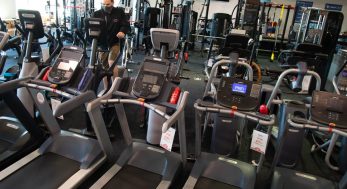Fitness trackers are popular today, and for good reason. They not only help guide exercise workouts such as running, swimming, or cycling, they can also help you and your health care professional understand your medical situations, such as detecting irregular heart rhythms. And they can help out in more day-to-day activities, such as weather reports and calendar alerts.
Shopping for a new fitness tracker can be a daunting task. There are a wide range of brands and price points to choose from. Fortunately, you can use a handful of key points to narrow your choice.
All about the sensors
The fundamental mission of these devices is to track your physical activity. They accomplish this by recording and interpreting data generated by a variety of sensors. Twenty years ago, these sensors would have weighed several pounds and cost thousands of dollars. Modern-day parts now are the size of a grain of sand and cost pennies.
The basic sensor is an accelerometer that detects linear acceleration. Typically, three of these are configured as a single unit, covering all three axes. In order to detect radial (rotating) motion, a tracker needs gyroscopes: again, one for each axis. Some trackers also include magnetometers that detect magnetic fields, making it possible to deduce which way is up. Not all trackers have all three types of motion sensors, but more sensors mean better results and more accurate data.
The other common type of sensor system in a tracker is for photoplethysmography, which is a fancy name for “detecting heartbeats using light.” This technology pairs one or more LED lights with light sensors mounted on the back of the device. The light reflects off blood and tissue and the amount of reflected light changes as heartbeats pump blood through the vessels.

Tracking your workout
Since a tracker’s main purpose is to help with workouts, most will have a timer feature that lets you set an alarm for a particular interval or use a stopwatch to track your session. Many trackers will also let you specify your workout activity, such as walking, running, swimming, or bike riding. Some devices, such as the Fitbit Charge 3, will even automatically recognize the type of activity when you start.
While on the topic of swimming, many trackers are now water resistant. If you want to wear your tracker during water activities (or in the shower), look for the IP rating. IP67 means that the device is rated for immersion in water as much as one meter deep for 30 minutes, while IP68 is rated for depths greater than one meter. Many trackers — such as the Misfit Shine 2 — are now rated as water resistant for up to 50 meters in depth.
If you’re looking to get the most out of your workouts, some trackers also offer heart rate variability, VO2 max, and recovery rate. These features can even be found in Bluetooth earphones like the Jabra Elite Sport. Runners and cyclists might want a tracker that includes GPS tracking without having to bring your phone along as well; the Garmin Vivosport has a GPS receiver built in.
Tracking your health
One feature that has received a lot of recent attention is the ability for the device to monitor electrocardiogram (EKG) data. This refers to the actual electrical waveforms of your heartbeats. These devices can even alert you when they detect a potentially dangerous heart arrhythmia (such as atrial fibrillation). The Withings Move ECG is one device that includes this feature.
Trackers can include a host of health features. This includes sleep tracking, hydration, food intake tracking, female health data, and reminders to get up and move from time to time.

Want more than just fitness?
Just about all fitness bands tell time and just about all smartwatches track your activity, so your choice of one or the other will be based on your taste, your budget, and how much more you want the device to do besides activity tracking.
Trackers are great for exercise enthusiasts, but the average consumer needs more if the tracker is to become an essential part of daily activities. One study reports that more than half of people who own a fitness tracker no longer use it.
This is where smartwatches come in. While the main purpose of fitness trackers is, logically, fitness, smartwatches let you upload apps for a variety of both fitness and non-fitness-related activities. In addition, smartwatches can offer a variety of watchfaces, the ability to take and answer calls, and to listen to audio. While many of these features can overlap (there are fitness trackers that also have some of these abilities), you’re going to get a lot more features out of a smartwatch — for a corresponding raise in price. For example, the Apple Watch Series 4 has cellphone circuitry built in, so you can leave your phone at home and still make and receive calls. The Fitbit Versa 2 includes wireless payment and built-in support for the Amazon Alexa voice assistant (although, according to our review, it’s a better fitness tracker than a smartwatch).
Also keep in mind
Battery life is a problem for some people. Most smartwatches will last for a few days between charges and some fitness bands can go for a week, but you may find that even this might be inconvenient. One solution is the Misfit Shine 2; it doesn’t recharge at all, but uses a replaceable (and inexpensive) coin battery that lasts up to six months. And the recently announced Garmin Fenix 6 smartwatch includes a solar cell that uses ambient light to extend the battery life between recharges.
Another consideration is the operating system support. Most devices use Bluetooth connections to share data with a smartphone, and in almost all cases the company provides apps for both Apple iOS and Android phones. There are exceptions; the Apple Watch is, as could be expected, designed to only work with iPhones. In general, however, your Android or iOS phone will work with most fitness trackers.
Making the choice
Prices range from less than $70 for a well-equipped fitness band to $1,500 or more for a blinged-out smartwatch. Most users will find excellent choices with a set of features that match their needs for $70 to $200 for either a fitness band or smartwatch. Pick the right one and it is less likely to end up in the back of your kitchen drawer after six months.
Vox Media has affiliate partnerships. These do not influence editorial content, though Vox Media may earn commissions for products purchased via affiliate links. For more information, see our ethics policy.

